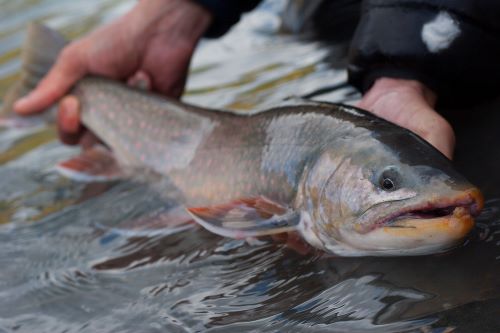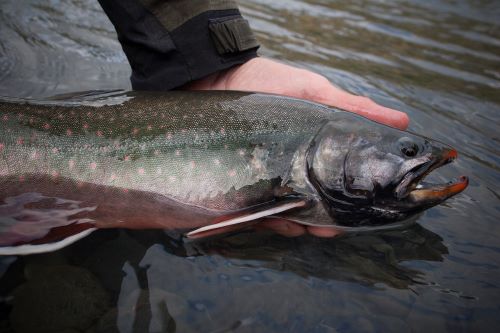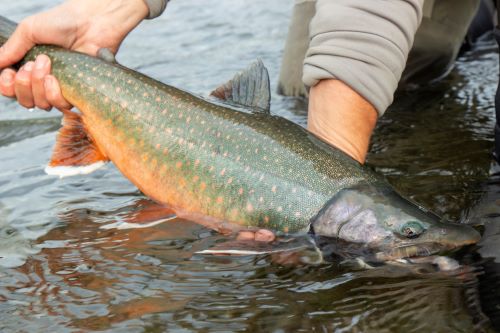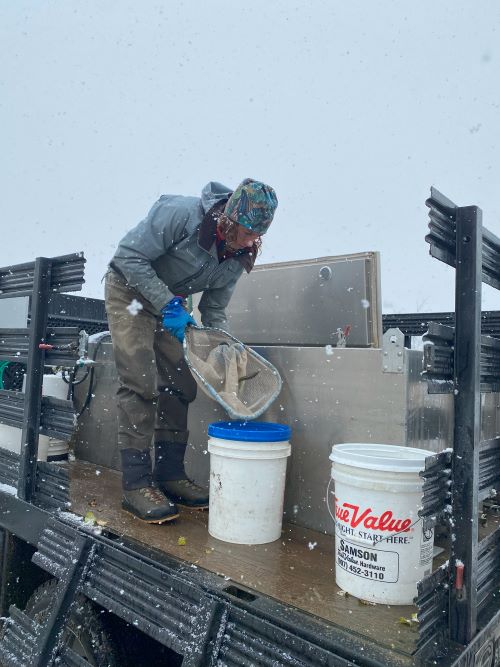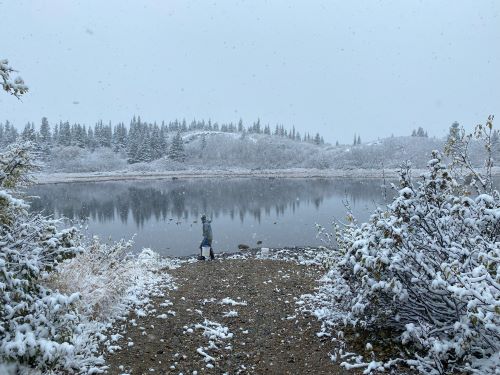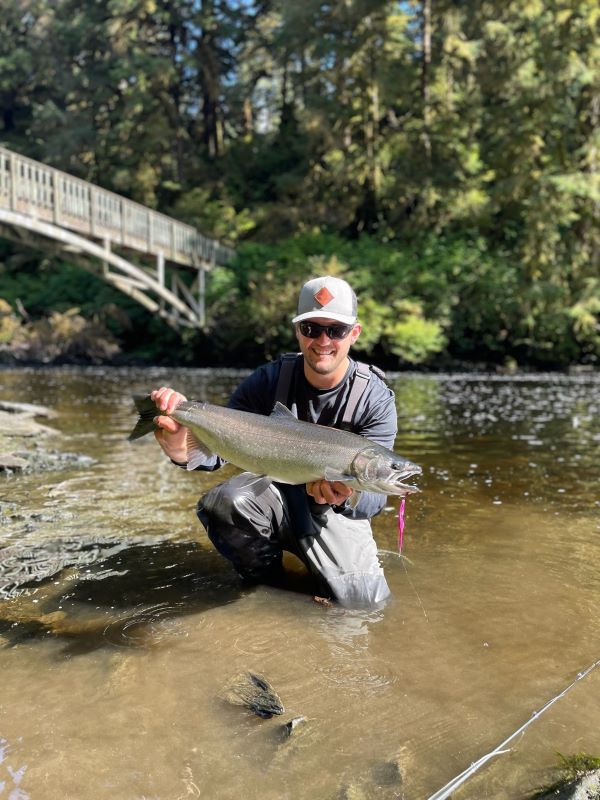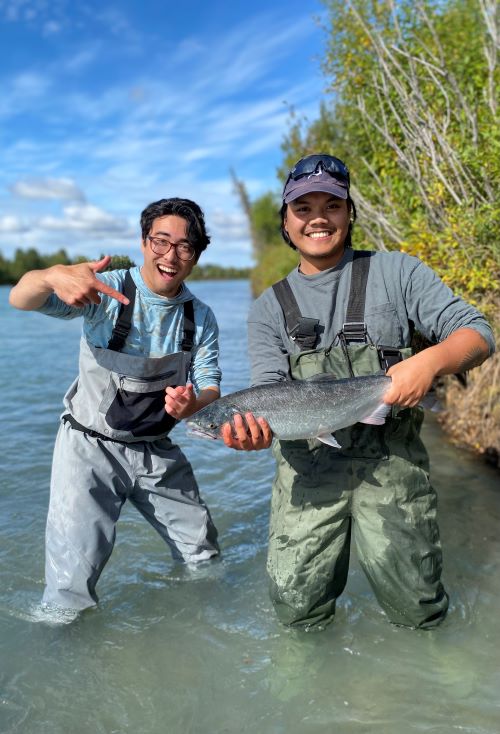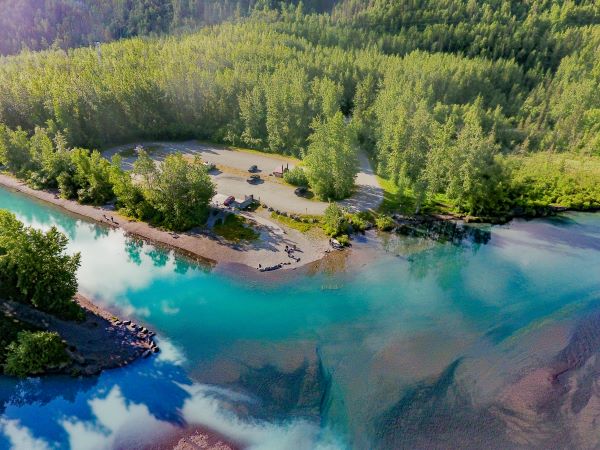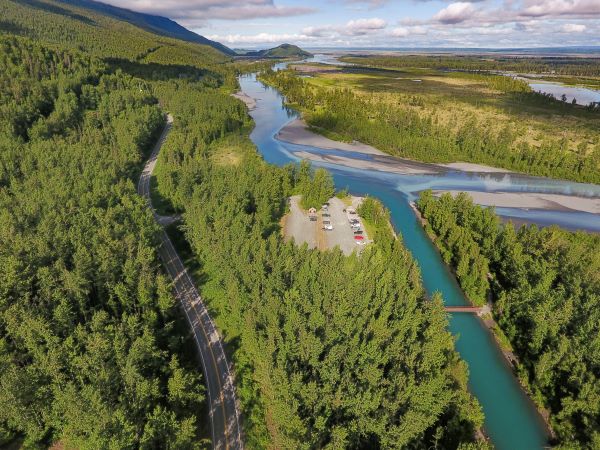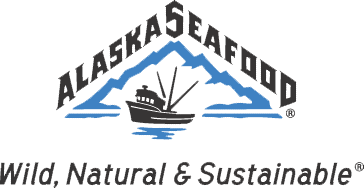
October 2025
Issue 94
Fall Fishing Highlights and A New Way to Enter the 2026 Photo Contest
Fall is here, and there’s still plenty of great fishing across Alaska! In this edition, we’re diving into Dolly Varden on the fly, sharing updates on fish stocking on Interior lakes, exploring Southeast’s Naha River, and highlighting improvements at the Eklutna Tailrace. Also, don’t miss your chance to enter the 2026 Sport Fishing Regulations photo contest.
Visit our online store if you need to purchase your 2025 sport fishing license. Or download the ADF&G mobile app and you can store your licenses, tags and permits in your mobile device.
If you have a comment or story ideas for Reel Times, we encourage you to send them our way. You can send comments to ryan.ragan@alaska.gov.
Fishing for Dolly Varden on the Fly
Dolly Varden are one of the most widely distributed salmonids in Alaska. There are two sub-species of Dolly Varden in Alaska, a northern species and a southern species. The northern species is found north of the Alaska Peninsula to the Mackenzie River in Canada. The southern species is found from southeast Alaska throughout the Gulf of Alaska to the south of the Alaska Peninsula.
Dolly Varden are olive green to dark blue or brown, with many yellow, orange, or red spots on the side. The largest spots are usually smaller than the pupil of the eye.
Dolly Varden are fall spawners, with spawning occurring in late September or October in Southcentral Alaska. Females, depending on their size, will deposit between 600 to 6,000 eggs into redds, or their gravel nests. Spawning places great physical demands on Dolly Varden. An estimated 70% of the males, and up to 60% of the females die after spawning.
By March, Dolly Varden eggs have developed into alevin, which survive off their yolk sacs. Once their yolk sac is absorbed, Dolly Varden fry will emerge from the gravel in April or May. Dolly Varden will rear in streams for two to four years before beginning their first migration to sea; however, some may rear as long as six years. Prior to their seaward migration to the ocean in May or June, Dolly Varden go through a series of physical changes called smoltification which allows them to survive in saltwater. During this process, Dolly Varden lose their parr marks and become silvery in color. A small number of Dolly Varden may migrate to the sea in September and October. After their first seaward migration, Dolly Varden usually spend the rest of their lives migrating to and from fresh water in an interesting and often complicated pattern of migration. The southern species migrate into lakes during the fall where they spend the winter.
Sea-run Dolly Varden have complex life histories, since they travel in both fresh and saltwater habitats. They may visit many freshwater streams in a single year, which may give an inaccurate impression of their numbers. This mobile lifestyle led Inupiaq Alaskans to assign Dollies different names—bright-colored fish entering a stream in summer were called ‘iqalukpik.’ Three months later, when the same fish was seen in post-spawning coloration, they were called ‘pyraulik.’
Unlike Pacific salmon, Dolly Varden are capable of spawning multiple times during their lives. It is generally believed that males do not spawn more than twice and females not more than three times. Those fish that spawn more than once are likely to spawn in consecutive years. This explains why fish rarely live more than nine years in Southcentral Alaska. Depending on food availability, adults, particularly the northern species, may skip a year or two between spawning events.
Targeting Dolly Varden during the fall months
Dolly Varden can typically be found in flowing waters during the fall months where they readily feed on the eggs of spawning salmon and the flesh of post-spawn decaying salmon. When targeting Dolly Varden during the salmon spawn, it’s recommended to use beads or fly patterns that mimic salmon eggs. There are several styles and sizes of beads available to anglers. It’s recommended that anglers try using 6, 8 or 10 mm beads during the fall months. “Fresh” looking beads mimic a salmon egg that was recently released by a female salmon. These colors include orange and red. A “dead” bead mimics the color of a salmon egg that has been in the water for a while, not deposited in the nest or “redd.” Dead beads are more subdued in color and are available in names such as “apricot swirl,” “cotton candy” and “cheese.”
Flesh flies work well when targeting Dolly Varden during the fall months. There are several styles of effective flesh fly patterns. You can check out a few styles on our YouTube channel.
To learn more about Dolly Varden, visit our species profile page.
Good luck targeting these beautiful fish.
Coho Salmon Stocking in the Interior
Our recent stocking efforts have led to a combined release of 60,613 coho (silver) salmon and Arctic char into eleven Interior lakes.
Fishing can be hot on cool, autumn weekends. There’s still time to enjoy some open-water fishing before winter sets in!
Lakes that have been recently stocked:
- Chena Lake
- Quartz Lake
- Birch Lake
- Grayling Lake
- Otto Lake
- Sheefish Lake
- Chena Hot Springs Road Pond Mile 47.9
- Nickel Lake
- Coal Mine #5 Lake
- Brodie Lake
- J Lake
To find out more about each of these lakes, check out the Alaska Lake Database.
Have fun out there!
Fall Fishing on the Naha River in Southeast Alaska
By: Kade Holling, Assistant Area Management Biologist, Ketchikan
Fall is here, bringing an end to summer. Although summer is often considered prime fishing season in Southeast Alaska, your opportunities don’t have to stop there. Late September and October can provide fantastic freshwater angling throughout Southeast Alaska. With coho returning, an abundance of trout, and even the chance to encounter a fall-run steelhead, the Naha River is a great destination close to Ketchikan.
To experience it firsthand, I made the trip myself. Before heading out, I did some pre-trip planning using the GoFishAK interactive map. With everything lined up, I left Knudson Cove early in the morning and made the quick 25-minute boat ride to the new U.S. Forest Service dock at Naha Bay. The dock, located toward the head of the bay before Roosevelt Lagoon, has plenty of space for multiple boats and serves as the main starting point for the trail.
From there I grabbed my pack with waders, fishing tackle, and other essentials and started the two-mile hike to the river. The trail follows the north side of Roosevelt Lagoon, alternating between dense forest and shoreline views. Roughly the first mile of trail leading to Orton Ranch has been rebuilt by the U.S. Forest Service and is in excellent condition. The remainder is the original boardwalk that is still accessible but slick in spots, so watch your step!
After reaching the outflow of the river, I continued upstream another mile until I came across a slow deep pool. I broke out my 8 wt. fly rod and tied on a large pink streamer. The first two casts went untouched but on the third cast, a chrome-bright coho slammed the fly and ripped downstream! A back-and-forth battle began between the fish and me, with the fish making powerful runs every time I brought it within reach. After several runs, I finally landed the fish! Coho this time of year often put up a strong fight and this one was no exception. Over the next hour I caught a few pink salmon and a rainbow trout before two black bears entered the river upstream, signaling it was time for me to give them space and find a different spot.
The Naha River offers much more than what I encountered. In addition to coho, the river sees returns of chum, pink, and sockeye salmon, along with steelhead, cutthroat trout, and Dolly Varden. If the timing is right, you could be lucky enough to complete most of the five salmon family challenge in one trip (more information here)! While targeting coho in September and October, anglers can also find good fishing for trout with smaller spoons, spinners, egg patterns, or beads. One of the unique opportunities this river has to offer is the chance to target fall-run steelhead on a catch-and-release basis, with the best timing typically from late October into early December. Above Heckman Lake lies a natural barrier falls preventing further salmon and steelhead passage, limiting anadromous fish to the lower sections of the river.
For anglers planning an extended trip, two U.S. Forest Service cabins are available along the trail: one at Jordan Lake and another at Heckman Lake. The full length of the trail is 5.8 miles to the cabin at Heckman Lake. Two additional cabins at Heckman Lake and Patching Lake can be accessed by floatplane.
Whether you’re chasing coho, hoping to find steelhead, or just looking to enjoy Southeast Alaska’s fall scenery, the Naha River has something for everyone. Be sure to check current regulations and stay bear-aware when you head out.
Share Your Catch in Just a Few Clicks
Big news, anglers! We’ve created an online submission form that streamlines the process for you, making it faster and easier to share your fishing photos for the 2026 Sport Fishing Regulations Cover Photo contest. Share your biggest catches, family adventures, or a day out with friends in just a few clicks! Already submitted photos by email this year? No need to resend. Prefer email? That option is still available; you now have the choice!
How to Enter:
- Visit this site from your phone or computer.
- Submit up to three photos taken in Alaska within the last two years (no screengrabs) and enter the necessary information.
- Complete the media consent release form online (parents/guardians must sign for kids under 18).
- Photos showing unsafe or unethical practices, fish/game violations, or advertisements will not be accepted.
Deadline: 5:00 p.m., Friday, October 31, 2025.
Your photo could be featured on the cover or inside pages of a 2026 Sport Fishing Regulations book!
Submit your photos online now, or email your regional contact. If emailing, you will need to include this signed PDF:
- Northern Alaska: Tim Mowry tim.mowry@alaska.gov
- Southcentral & Southwest Alaska:Nick Ellickson nick.ellickson@alaska.gov
- Southeast Alaska: Carly Lemieux carly.lemieux@alaska.gov
Improvements at the Eklutna Tailrace
By Andrew Garry, Region II Access Coordinator, Palmer
Beginning in the early 1980’s, the Eklutna Tailrace fishery has provided anglers with salmon fishing opportunities for over 40 years. The Alaska Department of Fish and Game has been committed to upgrading and managing the site for continued sport fishing opportunities. The Angler Access program kicked off design and construction in the early 2000’s, to reroute and improve the public access road to the mouth of the tailrace, increase the size of the parking lot, and provide ADA accessible trails, fishing pads, a bridge (to provide convenient access to both sides of the tailrace), toilet screens and improved refuse receptacles. Prior to this project, the site consisted of several undeveloped, single lane, rough roads to a small parking area at the mouth of the tailrace, unimproved pedestrian trails, and a small parking lot at the head of the tailrace located within the Old Glenn Highway right of way. The area between the highway and primary parking area at the mouth of the tailrace was heavily wooded and brushy, which encouraged squatter camps and vandalism of ADF&G-funded porta-potties, dumpsters, and signs. Given the poor, unimproved access to the site, it was difficult to get Alaska State Troopers or State Park Rangers to patrol the area. Major upgrades to the Eklutna Tailrace were completed in 2005.
The Eklutna Tailrace now includes a hardened parking lot, wheelchair-accessible paved trails, gravel walking trails, a pedestrian bridge, fish cleaning table, CXT vault latrines, bear resistant trash cans and refuse receptacles. The new entrance road and parking layout has provided safer access, better traffic flow, and increased parking capacity. The open-site design and improved access have enabled law enforcement agencies to easily patrol the area. The trails, bridge, and fishing pads provide easy, barrier free access to angling opportunities on both sides of the tailrace and the facility amenities provide easier site maintenance.
The Eklutna Tailrace fishery is located approximately 34 miles northeast of Anchorage near Mile 3.5 of the Old Glenn Highway.
Currently, the fishery is supported by coho and chinook salmon that are reared at the ADF&G William Jack Hernandez Sport Fish Hatchery and released into the tailrace as juveniles. The juvenile salmon will imprint on tailrace water for 5-7 days before being released. The “smolt” then volitionally out-migrate from the tailrace down the Knik River and into the Cook Inlet and beyond, where they will grow to adults. Depending on species, the salmon will then return to the tailrace as adults 1-5 years later. Coho salmon smolts have been stocked into the tailrace by ADF&G annually since 1998. Chinook salmon smolts were first stocked in May 2002.
While the Eklutna Tailrace is open to fishing year-round, the best king salmon fishing can be had during the month of June and into early July. A heavy action spinning rod with 20- or 30-pound test line, or a 9wt to 12wt fly rod, is recommended in landing a Chinook salmon in this water system. The recommended tackle to use when fishing the tailrace includes yarn flies in various colors, Pixee, or Vibrax. Many anglers will switch their setup to a Spin-n-Glo ahead of a quarter sized chunk of salmon roe in an egg loop knot with a 2 to 3 oz. pyramid weight on a sinker slider or under a slip bobber. Additional information such as bag and possession limits for all salmon species can be found under the Knik area in the current Southcentral Alaska Sport Fishing Regulations Summary booklet.
Visit the Access Program Webpage
Recipe of the month - Pink Salmon Rice Bowls (One-Pot Rice Cooker Meal)
Try this great recipe for Pink Salmon Rice Bowls (One-Pot Rice Cooker Meal) from the Alaska Seafood Marketing Institute.
Enjoy!
If you have any questions about the Reel Times newsletter, please contact Ryan Ragan at ryan.ragan@alaska.gov

